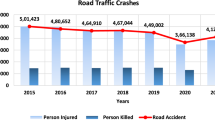Abstract
Traffic safety has long been a serious concern for people living in modern cities worldwide. In particular, urban intersections are locations where traffic accidents occur very frequently, and proactive assessment of accident risk is required for taking some particular countermeasures. Human reliability analysis (HRA) is a sophisticate method to evaluate human error probabilities, and it is widely used in various industries, but its application to accident risk in urban intersections is not straightforward. This paper discusses how to apply a second-generation HRA method to assessing accident risk in urban intersections. Contextual factors that affect driver reliability were identified, and then an assessment method of these factors for particular situations in driving through intersections was given. Field data were collected and analyzed for five intersections in the Tokyo metropolitan area with relatively high accident frequencies. The obtained result was compared with accident statistics, and it was demonstrated that the proposed method could well estimate accident risk in urban intersections.







Similar content being viewed by others
References
Bieder C, Le-Bot P, Desmares E, Bonnet JL, Cara F (1998) MERMOS: EDF’s new advanced HRA method. In: Mosleh A, Bari RA (eds) Proceedings 4th International Conference Probabilistic Safety Assessment and Management (PSAM4), New York, pp 129–134
Chipman ML, MacGregor CG, Smiley AM, Lee-Gosselin M (1992) Time vs. distance as measures of exposure in driving surveys. Accid Anal Prev 24:679–684
Denno (2004) OD safety test. http://www.dennoo.co.jp/od/index.html (Japanese)
MPD: Metropolitan Police Department (2009) http://www.keishicho.metro.tokyo.jp/anzen/sub5.htm (Japanese)
Dougherty EM (1990) Human reliability analysis—where shouldst thou turn. Reliab Eng Syst Saf 29:283–299
Ergonomics (1990) Special issue: Errors in the operation of transport systems 33:10–11
Gregoriades A, Sutcliffe A, Papageorgiou G, Louvieris P (2010) Human-centered safety analysis of prospective road designs. IEEE Trans Syst Man Cybernetics Part A 40:236–250
Gstalter H, Fastenmeier W (2010) Reliability of drivers in urban intersections. Accid Anal Prev 42:225–234
Hollnagel E (1993) Human reliability analysis: context and control. Academic Press, London, pp 203–232
Hollnagel E (1998) Cognitive reliability and error analysis method. Elsevier, Amsterdam
IRF: International Road Federation (2009) World Road Statistics. http://www.irfnet.org/files-upload/stats/2009/WRS2009_Publication.pdf
ITARDA: Institute for Traffic Accident Research and Data Analysis (2001) What types of human errors cause traffic accidents? ITARDA Information 33 (in Japanese)
Kuzminski P, Eisele JS, Garber N, Schwing R, Haimes YY, Li D, Chowdhury M (1995) Improvement of highway safety I: identification of causal factors through fault-tree modeling. Risk Anal 15:293–312
Kweon YJ, Kockelman KM (2003) Overall injury risk to different drivers: combining exposure, frequency, and severity models. Accid Anal Prev 35:441–450
Ng K, Hung W, Wong W (2002) An algorithm for assessing the risk of traffic accident. Accid Anal Prev 33:387–410
NPA: National Police Agency (2010) Traffic accidents situation. http://www.npa.go.jp/toukei/koutuu48/toukeie.htm
Ryan GA, Legge M, Rosman D (1998) Age related changes in drivers’ crash risk and crash type. Accid Anal Prev 30:379–387
Sayed T, Abdelwahab W, Navin F (1995) Identifying accident-prone locations using fuzzy pattern recognition. J Transp Eng 121:352–358
USNRC: United States Nuclear Regulatory Commission (2000) Technical bases and implementation guidelines for a technique for human event analysis (ATHEANA) NUREG-1628
Wang WH, Cao Q, Ikeuchi K, Bubb H (2010) Reliability and safety analysis methodology for identification of drivers’ erroneous actions. Int J Automot Technol 11:873–881
Yoshida Y, Ohtani M, Fujita Y (2003) Quantification of a decision-making failure probability of the accident management using cognitive analysis model. Trans At Energy Soc Jpn 2:99–114 (Japanese)
Author information
Authors and Affiliations
Corresponding author
Rights and permissions
About this article
Cite this article
Taga, H., Furuta, K. & Kanno, T. Human reliability analysis of car drivers in urban intersections. Cogn Tech Work 14, 365–377 (2012). https://doi.org/10.1007/s10111-011-0185-4
Received:
Accepted:
Published:
Issue Date:
DOI: https://doi.org/10.1007/s10111-011-0185-4




